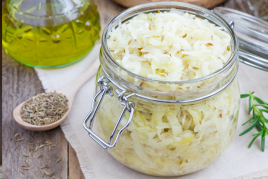Sauerkraut

We’re all going mad for sauerkraut, and it’s hardly surprising when you look at the long list of benefits that come with eating this ancient ferment. Not only is it good for gut health, it’s also reputed to boost your immune system, protect the health of your heart, eyes and bones and acts as an anti-inflammatory. What’s more, it’s also incredibly simple to make; read on to find out how… (recipe adapted from Ferment for Good by Sharon Flynn):
Sauerkraut
Level: Medium
Ingredients
- 2kg shredded organic green cabbage (like our beauties from The Community Farm). Keep one clean cabbage leaf aside.
50g fine ground salt
15g caraway seeds (optional)
- Special equipment
- 2L clean, airtight storage jar
A large food pounder/pestle
A weight to fit the mouth of the jar – our source suggests a large chunk of raw vegetable such as carrot.
Method
Weigh the shredded cabbage to ensure that you have the correct cabbage/salt ratio. The salt should be no more than 3% of the cabbage’s weight, and ideally 1.5-2.5%.
In a large bowl, massage the salt into the leaves thoroughly, being careful to distribute it evenly.
Let the mixture sit for ten minutes. Use this time to clean your jar thoroughly.
Using either the pounder, or just your hands, pound or vigorously massage the cabbage for about 10 minutes, until the mixture drips with brine when you pick it up.
Stir through the caraway seeds, if using.
Transfer the mixture to the jar, packing it down tightly to get all the air out. Make sure the last of the cabbage is pushed below the level of the brine. Make sure there is space at the top of the jar for a weight.
Now place your clean cabbage leaf over the top of the mixture, followed by your vegetable weight. Seal the lid so that it presses down on the weight, keeping the sauerkraut submerged, but do remember to let the gases out each day especially in warmer weather.
Now leave the mixture to ferment. Bubbles will begin to rise to the surface after the first day or so. We recommend leaving it for a week or two, but you can try as it goes to suit your taste.
Once the sauerkraut is ready, seal the jar and move it to the fridge where it will keep for 12 months or more – use your senses.
If a white mould develops on the top of the sauerkraut at any point in the process, don’t panic! Scrape it off, remove any badly tainted leaves and make sure the remaining cabbage is fully submerged.
Most Popular
- Roast Squash
- Three Delicious Ways to Cook Herring
- Coconut Shortcrust Pastry
- Fresh garlic: our guide on how to use it
- Braised lamb shoulder with puy lentils & purple sprouting broccoli
- VEGAN LEEK AND POTATO PIE
- SWEDE AND CHICKPEA CURRY
- Banana Bread with Roast Chestnuts
- Kohlrabi slaw
- Zesty Slow-Baked Salmon
- Roasted Brussels Sprout, Mushroom and Kale Salad
- Courgette and Kale Pilaf
- Low waste cottage cheese
- Vegan Scotch Pancakes
- Nutty Mushroom Wellington
